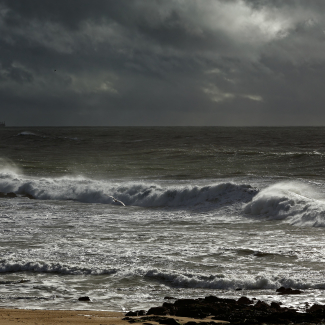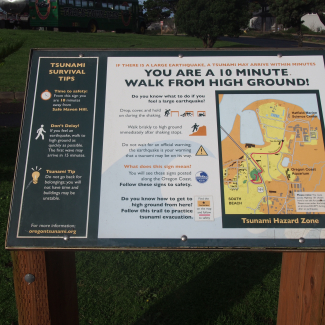What event happens underwater to cause a tsunami?
Tsunamis are just long waves — really long waves. Just what is a moving ridge? Sound waves, radio waves, even "the moving ridge" in a stadium all take something in mutual with the waves that move across oceans. It takes an external force to start a wave, like dropping a rock into a pond or waves bravado across the sea. In the instance of tsunamis, the forces involved are large — and their effects can exist correspondingly massive.
What is a tsunami?
A tsunami is a series of extremely long waves acquired by a large and sudden displacement of the body of water, usually the issue of an convulsion below or near the sea floor. This force creates waves that radiate outward in all directions away from their source, sometimes crossing unabridged ocean basins. Unlike wind-driven waves, which simply travel through the topmost layer of the ocean, tsunamis move through the entire h2o column, from the bounding main floor to the ocean surface.

In 1964, tsunamis devastated littoral communities in Alaska. Impacts were felt along U.Southward. and Canadian west coasts and in Hawaii…
What causes tsunamis?
Almost tsunamis are caused past earthquakes on converging tectonic plate boundaries. Co-ordinate to the Global Historical Tsunami Database, since 1900, over 80% of likely tsunamis were generated by earthquakes. However, tsunamis tin also exist caused by landslides, volcanic action, certain types of weather, and—possibly—most-earth objects (e.m., asteroids, comets) colliding with or exploding above the ocean.
Tsunami motion
Once a tsunami forms, its speed depends on the depth of the ocean. In the deep sea, a tsunami tin can move as fast every bit a jet plane, over 500 mph, and its wavelength, the distance from crest to crest, may exist hundreds of miles. Mariners at sea will not normally find a tsunami every bit it passes beneath them; in deep h2o, the top of the moving ridge rarely reaches more than three feet higher than the ocean swell. NOAA Deep-body of water Cess and Reporting of Tsunami (Dart) systems, located in the deep sea, are able to detect minor changes in sea-level tiptop and transmit this data to tsunami warning centers.

Driven by severe weather condition, these waves exacerbate flooding, erosion and can cause injury
Tsunami safe
A seismic sea wave only becomes hazardous when it approaches country. As a tsunami enters shallow water well-nigh coastal shorelines, it slows offsite link to 20 to 30 mph. The wavelength decreases, the height increases, and currents intensify.
Seismic sea wave warnings come in different forms. There are official warnings issued by seismic sea wave warning centers that are broadcast through local radio and television, wireless emergency alerts, NOAA Atmospheric condition Radios, NOAA websites, and social media. They may besides come through outdoor sirens, local officials, text message alerts, and phone notifications. There may not be time to wait for an official warning, so it is important to be able to recognize natural tsunami warnings. These include stiff or long earthquakes, a loud roar (like that of a railroad train or an aeroplane) coming from the ocean, and a sudden rise or fall of the bounding main level that is non related to the tide. Official and natural warnings are every bit of import. Be prepared to respond immediately to any tsunami warnings. Movement quickly to a safe place by following posted evacuation signs. If y'all do not see an evacuation route, go to high ground or as far inland as possible.
When they strike land, nearly tsunamis are less than ten anxiety high, simply in extreme cases, they can exceed 100 feet near their source. A tsunami may come onshore like a fast-ascension flood or a wall of turbulent water, and a big seismic sea wave tin alluvion low-lying coastal areas more than than a mile inland.
Rushing water from waves, floods, and rivers is incredibly powerful. But vi inches of fast-moving water can knock adults off their feet, and twelve inches can carry away a pocket-size auto. Tsunamis tin be especially destructive considering of their speed and book. They are also dangerous as they return to the sea, carrying droppings and people with them. The starting time wave in a seismic sea wave may non be the last, the largest, or the well-nigh damaging. Stay out of the tsunami hazard zone until local officials tell you it is prophylactic, equally the danger may last for hours or days.

"We demand to find a sugariness spot betwixt fear and activity..."
Tsunami effects on humans
Big tsunamis are significant threats to human health, property, infrastructure, resource, and economies. Effects can be long-lasting, and felt far beyond the coastline. Tsunamis typically cause the almost severe damage and casualties virtually their source, where there is little time for warning. Just big tsunamis tin also reach distant shorelines, causing widespread damage. The 2004 Indian Ocean tsunami, for example, impacted 17 countries in Southeastern and Southern Asia and Eastern and Southern Africa.
Tsunami forecasting
Scientists cannot predict when and where the next seismic sea wave will strike. But the seismic sea wave alarm centers know which earthquakes are probable to generate tsunamis and can issue messages when 1 is possible. They monitor networks of deep-ocean and coastal sea-level observation systems designed to observe tsunamis and employ information from these networks to forecast coastal impacts and guide local decisions about evacuation. Tsunami alarm capabilities have become dramatically better since the 2004 Indian Ocean seismic sea wave. NOAA scientists are working to further improve warning center operations and to help communities be prepared to respond.

NOAA's tsunami warning capabilities have profoundly improved since the 2004 Indian Body of water tsunami...
EDUCATION Connection
Students can investigate tsunamis to discover the impacts of World's systems on humans. Teachers tin can use these potentially deadly waves and other natural hazards to bring relevance to science concepts such as plate tectonics, acceleration and speed, forcefulness and motion, free energy transfer, and the physics of waves. In add-on, many schools, homes, and businesses are located in tsunami hazard zones offsite link. Many coastal states and territories accept tsunami preparedness campaigns in place. Teaching students virtually tsunami safety and preparedness plans may ultimately save lives.
Source: https://www.noaa.gov/education/resource-collections/ocean-coasts/tsunamis
0 Response to "What event happens underwater to cause a tsunami?"
Post a Comment